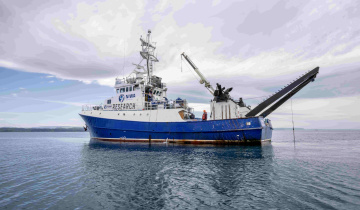The kōaro was once abundant in the Te Arawa lakes near Rotorua in New Zealand’s North Island. NIWA has assessed the viability of restoring this species in the region.
Key findings
Our research has shown that the freshwater fish kōaro (Galaxias brevipinnis), which was once the dominant fish and the subject of important Maori fisheries in the Rotorua (Te Arawa) lakes, is in significant decline.
Some small lakes offer the potential for restoration of kōaro if trout and smelt can be eradicated with pesticides that target these species.
Restoring lake populations of kōaro will not be possible in other lakes, because control of trout and smelt is neither viable nor desirable due to the high value of the trout fisheries. However, residual kōaro populations can be maintained and protected in some of the small streams that enter these lakes, as the streams are not important for trout spawning or rearing.
The problem
The kōaro (Galaxias brevipinnis) was once abundant, and the dominant fish in the Te Arawa lakes near Rotorua in New Zealand’s North Island. They were a significant fisheries resource for Māori, who harvested adults (kōkopu) and juveniles (inanga) using nets and traps crafted from flax and native woods. As a major source of protein, the kōaro fisheries were an integral part of tikanga and were a taonga species for Te Arawa.
In the early 1900s, brown trout and rainbow trout were introduced to the Te Arawa lakes and the kōaro fisheries collapsed as a result of heavy trout predation on kōaro. However, predators rarely eliminate their prey and the kōaro stocks remained at a low level until the 1930s, when smelt were introduced as a forage fish for trout.
This introduction enhanced the trout fisheries but it was the death knell for kōaro. Smelt out-competed inanga for the plankton they both eat and also preyed on kōaro larvae. Kōaro became rare or extinct in these lakes, retreating to the few inlet streams where a native bush canopy remained and where trout access was limited. This continued until the bush was cleared for pasture, at which point kōaro disappeared from these streams as well.
When management of the Rotorua lakes was returned to Te Arawa in the Te Arawa Lakes Settlement Act 2006, the status of kōaro was unknown and there was little information on which to base future management of this species. Since then, NIWA has been investigating the fish’s current status for the Te Arawa Lakes Trust through a series of stream surveys. Increasing our knowledge of this species will allow better management by Te Arawa and other management agencies.
The solution
NIWA undertook an extensive survey of inlet streams of all major lakes in the Rotorua region, focusing on those covered by Te Arawa’s settlement. These surveys have increased the known stream populations of kōaro from 12 to 16, but revealed that kōaro are now extinct in four lakes and probably extinct in another six.
Relict populations are confined to a few inlet streams in another four lakes, and kōaro are secure only in Lake Okataina, where they are common in all six of the inlet streams.
We have developed a restoration options paper for kōaro in the Rotorua lakes. Restoring lake populations of kōaro will not be possible in many lakes because they contain valued trout fisheries or else the lakes are too large for effective remove of all trout and smelt. Some smaller lakes offer restoration potential, being of lower value as trout fisheries. Trout and smelt eradication using pesticides may be feasible in these lakes.
Where trout fisheries are important, the only feasible restoration of kōaro populations is in the inlet streams. This is the focus of restoration work being undertaken in Lake Rotoaira near Taupo. Restoration techniques include:
- excluding trout from the small streams that are not required to sustain the trout population
- creating stream habitat for kōaro by planting riparian (streamside)strips with trees
- re-establishing kōaro in streams from which they are now absent.
Trout exclusion involves creating barriers to fish migrating upstream, followed by removal of trout from above these barriers. Such barriers have been used successfully in the USA, Australia, and New Zealand to protect indigenous fish from trout: they won’t exclude migrating kōaro because the fish are such excellent climbers.
The result
We believe some restoration is both feasible and necessary to protect and enhance the stocks of this former taonga species before it declines further and extinction occurs in even more of the Te Arawa lakes.
A number of local landowners have expressed interest in preserving kōaro in the streams on their properties. Additionally, at a recent meeting to discuss this project, the Te Arawa Lakes Trust, Environment Bay of Plenty, Department of Conservation and Fish and Game all expressed strong support for it and a desire for restoration to proceed on a case-by-case basis.
Roku Mihinui (Te Arawa Lakes Trust), Hera Smith (Te Arawa Lakes Trust), Matt Bloxham (BOPRC) 769, 963
External People Invovled:
Roku Mihinui (Te Arawa Lakes Trust)
Hera Smith (Te Arawa Lakes Trust)
Matt Bloxham (BOPRC)







